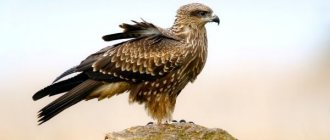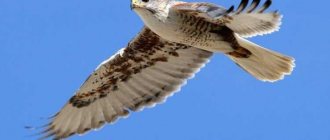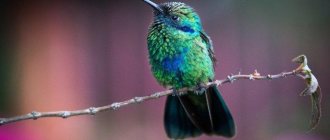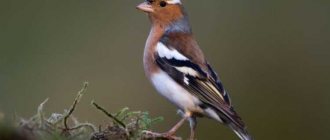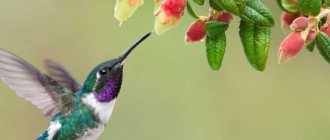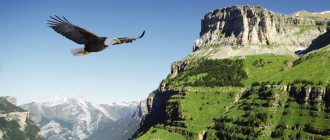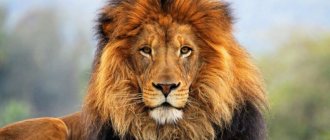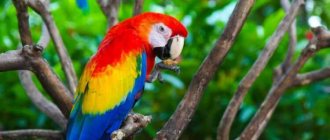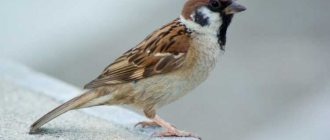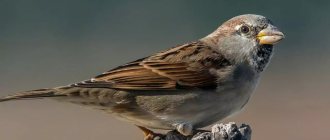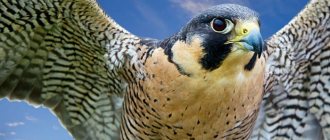- Wild animals
- >>
- Birds
Falcon is a feathered predator of the falcon family.
They are very common in the modern animal world and have a huge number of varieties. Since time immemorial, their behavior and habits have been studied quite well by humans, which has made it possible to use these birds of prey for hunting game. Falconry is still very popular to this day, not only as a form of fishing, but also as part of the culture of many nationalities, and as sporting entertainment. The falcon is a beautiful and noble bird, rightfully considered the fastest animal on Earth. When hunting, falcons are able to reach flight speeds of more than 320 km/h.
What does it look like
— Advertising —
Falcon flaps its wings
The scientific name Falco comes from the word "falx", which means "sickle" - the sickle shape of the wings distinguishes falcons from other species of birds. Birds' wings are long and wide, thanks to which falcons are able to rise high into the sky and soar freely. The falcon feather is hard and glossy.
Photo of a falcon close up
The body of falcons is knocked down, rounded; The chest is wide and convex. The tail is long and shaped like a wedge. The head is large; the beak is small, strongly curved down. There are sharp teeth on the beak. The eyes are large, the skin around them is bare. The paws are thick, of medium length, four-toed.
— Advertising —
Evil look of a falcon
The color of the feather is individual for each individual species. Gray and brown tones predominate in most bird species. The plumage is not monochromatic - the main color is diluted with streaks and strokes of different sizes and colors. The irises of the eyes are usually black, the paws are bright yellow, sometimes feathered.
Nesting
The peregrine falcon, having selected a suitable female, makes a mating flight in front of her, during which he transfers the prey to her. If the female agrees to accept courtship, she turns over in the air and, hovering in the sky with her back down for some time, accepts prey from the male’s claws. After this, the pair is considered formed and can begin to select a suitable nesting site, which in most cases occurs in large forests, among which there are large mountain ranges.
Peregrine falcons nest in the cracks of steep rocks, but prefer to use abandoned nests of other birds of prey for housing, which they straighten so that the falcon-chick feels most comfortable. This nest is quite spacious and can accommodate parents and chicks. In addition, due to its design and inaccessible placement, it is reliably protected from predators. When peregrine falcons have to build a nest on the ground and rocks, they limit themselves to constructing primitive bedding, which is assembled from several branches and large feathers. If the nest is in a good place and made well, several generations of birds can live in it. Moreover, each pair always has several spare nests in case the main one is destroyed.
Female and male: main differences
Female and male falcons
Most species of falcons lack sexual dimorphism. Meanwhile, females are distinguished from males by size: “girls” are always larger than “boys.” Males of some species are more variegated in color, with the area around the eyes having a bright tint.
Female
Female falcons are one and a half times larger than males. The weight of some birds reaches 1-1.5 kilograms. Females have a color similar to their partners, however, during breeding, the color of the feather fades somewhat. A greater difference between females and males is observed in the falcon species. The female falcon is colored in brown and fawn tones, with a black transverse stripe on its back. There are whitish streaks on the wings and tail.
Male
Falcon on the hunt
The body weight of a male falcon ranges from 150-500 grams. Males, like females, have brown, fawn, and ocher colors in their plumage. In male falcons, compared to females, the upper part of the body is dark gray with a blue “patina”, the lower abdomen is dirty red.
Save Status
The most serious threat facing falcon populations today is habitat destruction due to intensive human land use, including logging and forest clearing.
Many species of falcons also suffered population declines in the 1960s and 1970s due to poisoning resulting from the widespread use of organochlorine pesticides. Although the use of chemicals has been phased out in many countries, it continues in some less developed countries. Local threats to falcon populations include:
- introduced predators;
- poisoning with poisons intended for other species of animals;
- colliding with man-made objects such as cars, windows and windmills;
- catching birds and collecting eggs for trade;
- electric shock on power lines.
Several species of falcons have successfully adapted to urban landscapes. For example, peregrine falcons are capable of nesting on buildings, bridges and overpasses and are able to achieve similar and sometimes even higher reproductive success compared to pairs nesting in more natural landscapes.
In the entire history of existence, only one species of falcon has become extinct. The Reunion kestrel (Falco duboisi) became extinct around 1700. Today, the IUCN lists 4 species as Vulnerable and 6 species as Endangered.
falcon flight
Falcon in flight
Falcons are considered the fastest birds. The flight of a predator is fast, maneuverable, and swift. In flight, the falcon's speed is 90-100 kilometers per hour. The fastest bird in the falcon family is the peregrine falcon. Its flight speed while pursuing prey reaches 280-320 kilometers per hour. In one second, the falcon makes 4-5 wing flaps.
Key Features
Peregrine falcons are fearless and intelligent. They easily take root in cities, hunting pigeons and jackdaws. Skillful hunters, peregrine falcons are no less formidable defenders of their territory. A pair of falcons can easily drive away a small four-legged predator, and even a large one will not be happy when the mother comes to the defense of her chicks. As a true predator, Falco peregrinus does not hesitate to destroy the nests of other birds.
The birds are highly trainable and have long been used by people in falconry. A good peregrine falcon hunter is quite expensive, but a person gets no less pleasure from contemplating his skillful work.
The basis of the peregrine falcon's diet is birds. Ducks, pigeons, sparrows, thrushes, starlings are traditional falcon hunting objects. Sometimes a predator can attack small rodents if they are gaping in an open space
Spreading
Falcon on a stone
Falcons are found all over the world. Its habitat covers the American continent, Eurasia, Australia and Africa. These birds are not found only in Antarctica.
Falcon's gaze
Several species of falcons live in Russia - gyrfalcons, peregrine falcons, Amur falcon, etc. A large population of birds nests on the Chukotka Peninsula, on the coast of the Bering Sea, in Kamchatka.
Habitats
Falcon in the swamp
Birds of prey prefer to settle in open areas. They hunt in meadows, savannas, and wide forest clearings. Nests are made on tree branches and in rocky cavities. They always live next to a body of water. Some species of falcons, such as the gyrfalcon, nest near human habitation.
Falcon: migratory bird or not
Falcon flies in the sky
Most species lead a sedentary lifestyle. Only young birds fly south. Sexually mature birds migrate to the south of their habitat for the winter, not moving more than 500 kilometers from their previous place. Falcons are inquisitive by nature, so they spend a lot of time exploring the world. During educational walks, falcons can fly from home to a distance of a thousand kilometers. Many falcons spend their entire lives endlessly “moving.”
Habitat
You can meet a falcon in any corner of the world, except for the poles. Only young birds migrate for the winter. Adults prefer to stay at home, only moving closer to rivers and lakes.
Falcons can be seen mainly in steppe and semi-desert areas. Some subspecies live on the coast of Northern Europe. You can see these predators in our country.
A falcon can be trained. The main thing is to add a few game elements to the exercises. But you should still remember that this is, first of all, a predator. Yes, he can become attached to his owner, but you should not let your guard down.
Nutrition
Falcon eats its prey
Falcons feed on medium-sized birds. The diet includes pigeons, starlings, and sparrows. Forest falcons hunt black grouse, partridges, owls, and owls. Birds living near ponds feast on ducks, razorbills, and ducks. In rare cases, falcons hunt small mammals - lemmings, hares, squirrels, gophers.
Behavior
Most falcons are solitary and territorial birds, although some species are colonial or semi-colonial. They can lead a sedentary or migratory lifestyle. Of those species that do migrate, some individuals fly long distances (up to 20,000 km) between breeding and wintering grounds, while others make only short flights, for example from a high-altitude breeding area to a lower wintering area where food is more plentiful . Some species are partially migratory; only part of the population migrates when food becomes scarcer. For example, the females of some kestrels migrate while the males remain on their breeding grounds year-round.
Photo: National Aviation
Most falcons are diurnal, although some are primarily crepuscular birds. Individuals have a usual place where they return to roost at night. Falcons spend a significant amount of time grooming, preening, and bathing in dust or water, presumably because the condition of the plumage affects their ability to catch prey. Falcons are generally strong and powerful fliers. One of the most spectacular fliers are peregrine falcons, which can reach speeds of up to 180 km per hour.
Communication and perception
Falcons use vocalizations to communicate territorial ownership, to communicate with conspecifics, and in territorial or food disputes. Pairs of nesting Forest Falcons sing duets before sunrise, apparently to mark their territory and strengthen the pair bond. Chicks and nursing females also use vocalizations to ask the male for food. Falcon vocalizations are simple, repetitive, monosyllabic calls that are described as cackling, chirping, squawking, cawing, squawking, and whining.
Photo: Cocoa Smiles
Other forms of communication include flight displays, such as repeated swoops near a nest to mark personal territory or as part of courtship. Plumage patterns and other physical characteristics can also serve as signals of good health or valor.
Vision is the most important sense used in hunting. Falcons have exceptional vision, which they use to catch fast-moving prey. Sound is also used by some forest species when hunting, many of them have stiff feathers around their faces that help pick up sound vibrations.
Lifestyle
Falcon cries
Falcons are solitary birds. They do not gather in flocks even during migrations. Birds prefer to stay in pairs and build nests far from relatives (at a distance of 2-3 kilometers).
These birds can deftly maneuver, reach incredible speeds in flight, and deal with their prey in the air with lightning speed. At the same time, on the ground the bird does not behave so quickly and confidently. The falcon's steps on a flat surface are uncertain and clumsy. In this state, the falcon often becomes a victim of foxes, weasels and martens.
Falcon hunts hare
Falcon is a master of the hunt. Chasing prey, the bird can cover up to three hundred kilometers in an hour. Birds attack victims in the air. Sometimes, when hunting an animal, a falcon deliberately scares it so that it runs: catching “lunch” at high speed is an exciting activity for a falcon. Well-fed falcons are busy with active games in the air - they arrange comic fights with their brothers, plan for hours, and perform exciting pirouettes.
The lifespan of falcons is 15-16 years. However, in the wild, not all birds survive to the age limit. In captivity, birds can live 18-20 years.
Falcon hunting
Falcon hunts in winter.
Falcons hunt in the air. Birds spend hours gliding in the sky in search of prey. Having noticed the prey, the bird rises high above it (to gain speed), and then quickly rushes vertically down towards the prey. Having reached the victim, it strikes it with force with its muscular paws. The kick can be so strong that the game dies instantly. Having killed an animal, the falcon brings it to a quiet place, where it first plucks and butchers it, and only then eats it.
Two falcons cannot divide their prey
Every day one falcon eats 200-250 grams of food. In a hungry year, the predator eats the whole prey, but if the bird does not lack food, it can only eat large muscles.
Reproduction
Photo of a
falcon Falcons are monogamous birds. Different species have their own nesting periods: southern falcons mate in the summer - from July to September; birds living in the north breed from February to March. Mating rituals are similar among all bird species. The male presents the female he likes with a gift - a twig or leaf. Ritual dances of males last 7-10 days. At this time, birds circle in the sky and constantly sing loud, ringing songs.
Falcon family
Mating of partners takes place in the sky. Sometimes you can see how birds, clinging to each other with their claws, rise high into the sky, and then suddenly rush to the ground. The diving flight lasts 5-10 seconds, then the falcons begin to smoothly rise upward again.
Chicks and falcon in the nest
Birds choose secluded, quiet places to nest. Birds nest on the tops of trees, under the eaves of buildings or in rock gorges. Some species of falcons prefer not to waste time on arranging their homes, and occupy the abandoned nests of other birds. The female lays 2-4 large, red-colored eggs at a time. The larger the bird, the more eggs it can lay. Both parents are involved in breeding offspring. While the female sits on the eggs, the male feeds. Then the parents change. The incubation period is 29-32 days.
Falcon chicks
Photo of a falcon chick.
Falcon chicks are born sighted and well-furred. The fluff is dirty white. For the first three weeks of life, parents warm and feed the chicks and protect them from birds of prey and animals. The diet of chicks includes insects, eggs of other birds, and lizards.
A falcon chick in a man's hand
After a month, the falcon chick already knows how to get its own food and defend itself from enemies. During this period, the falcon leaves the parent's nest. He does this because the parents stop seeing him as their baby and begin to treat him as a competitor for food. If the chick does not leave the nesting site in time, the adults may peck at it.
Two falcon chicks
In the first year of life, grown falcons fly to warm countries for the winter. By the age of two they reach sexual maturity - from then on, most of them stop migrating.
Social structure and reproduction
Photo: Pair of falcons
As an effective predator, the falcon does not group with other relatives, preferring a pair existence. In nature, falcons are monogamous. A couple can only change if one of the partners dies. Falcons do not build nests on the ground, preferring to choose rocks, but they can also take over someone else's abandoned nest.
The mating games of falcons are distinguished by the breathtaking beauty of their flight. The speed and grace of the pair's stunts are simply incredible. Sometimes the aerial performance ends right at the ground. When choosing a male, the female sits next to him, demonstrating that she accepts his attention. The male can court the female, bringing her food in flight, while she turns over with her belly up, accepting the gift.
Falcons never build nests at close range, maintaining a distance of 2-3 km. A falcon's clutch contains from 2 to 5 eggs. Hatching lasts about a month. If the couple decides that there is not enough food in the chosen territory to feed the chicks, the birds leave the nest to create a new one in an area more comfortable for raising offspring.
Both parents take part in incubating the eggs. The hatched chicks remain under the protection of their parents for some time, learning to hunt and survive. But barely reaching adulthood, they turn into competitors in the fight for prey. Young falcons quickly become independent, leaving the nest approximately a month and a half after birth.
After a year, the chicks can have their own nest. The number of offspring depends on many factors, one of which is certainly the adequate nutrition of the female.
Types of falcons
The Falcon genus includes 40 species of birds, each of which includes from 2 to 20 subspecies. Falcons are conventionally divided into three large groups:
- All species of kestrel are small birds with well-defined sexual dimorphism.
- All species of Hobbies are slender, medium-sized birds.
- Falcons themselves are large representatives of the Falcon genus.
Saker falcons, gyrfalcons, lanners and laggars are sometimes classified as a separate group, Hierofalco.
Let's look at the common types of falcons:
Peregrine falcon (Falco peregrinus)
Peregrine falcon on a stone
Appearance: a large bird with a body length of up to 50 centimeters, a wingspan of 80-120 centimeters, and a weight of up to 800 grams. The bird is slightly larger in size than a crow. The plumage of the back is dark gray, the belly is motley, the head and “whiskers” are black.
Distribution: Peregrine falcons live in Eurasia, America, Australia and Africa. Depending on their distribution area, plumage color and size, 17 species of peregrine falcons are distinguished.
Peregrine falcon in flight
Features: Peregrine falcons are the fastest among other types of falcons. In a diving flight, the speed reaches 322 kilometers per hour. The peregrine falcon bird is listed in the Red Book of Russia. Hunting and trading of peregrine falcons is prohibited in all countries of the world.
Red falcon (Falco vespertinus)
Falcon on a tree
Appearance: a small bird, similar in appearance to another type of falcon - the kestrel. Body length – 28-33 centimeters, wingspan – 65-75 centimeters, weight – 130-180 grams. The falcon has a short beak and narrow, short wings. The color contains black, brown and brown shades. The paws and area around the eyes are red in both males and females.
Distribution: The falcon lives in wooded areas of Eurasia, settling along rivers. The Amur falcon lives in the East of Russia. The bird winters in South Africa and Indonesia.
Falcon in the field
Features: falcons nest in colonies of 800-100 pairs. They feed on insects living near bodies of water - dragonflies, mosquitoes, grasshoppers. Forest falcons feed on mice and lizards.
Southern Mexican falcon or aplomado (Falco femoralis)
Photo of a South Mexican falcon
Appearance: a medium-sized bird with a body length of up to 40 centimeters and a weight of 200-300 grams. The body is downed, rounded with short wings and a long narrow tail. The top of the head, back, wings and tail are gray-brown; The neck, throat and “cheeks” are white with black streaks. Males and females are colored the same.
Distribution: Aplomado is distributed in the southern United States, Mexico and northern Latin America. It nests in meadows and savannas near fresh water bodies.
Aplomado flaps his wings
Features: The South Mexican falcon feeds on birds - pigeons and passerines. In America, this type of bird is used for falconry.
Hobby (Falco subbuteo)
Hobby's look
Appearance: a bird whose body length reaches 36 centimeters, wingspan - 65-85 centimeters, weight - up to 350 grams. The back and head are dark brown with a grayish tint; the chest and belly are white with numerous ocher longitudinal streaks; the tail is light brown with longitudinal wide brown stripes. The legs and beak are yellow.
Hobby in the water
Distribution: in Eurasia, the Hobby is distributed mainly in northern latitudes; the population lives in Scandinavia. For the winter it migrates to Africa and South Asia. It nests in open areas near rivers and lakes.
Hobby in flight
Features: falcons of this species do not build their own nests. They prefer to occupy the homes of other birds of prey. The Hobby is a common species of falcon. There are up to 3 million Hobbies in the wild.
Kestrel (Falco tinnunculus)
Kestrel on a tree
Appearance: the kestrel is least similar to falcons. This bird has a large head with a small, weak beak. The plumage contains gray color, which is also a distinctive feature of kestrels. The shoulders of the gray wings are brown in tone. The underparts are beige with numerous spots of black.
Kestrel on a stone
Distribution: There are 12-15 species of kestrel, two of which - the common kestrel and the steppe kestrel - live in Russia. The steppe kestrel is an endangered species, listed in the Red Book of Russia.
Kestrel in flight
Features: The hunting pattern of the kestrel is different from other types of falcons. The bird is not active in flight; it mostly floats lazily in the air. Looks out for the victim at a height of 10 meters. Catches prey on the fly.
Saker Falcon (Falco cherrug)
Saker falcon is irritated
Appearance: large-sized bird. The body length is 57-60 centimeters, weight – up to 1300 grams. Each saker falcon has an individual feather color. The body is predominantly ocher in color with a variable amount of light and dark streaks. The chest is light with dark longitudinal strokes. The beak is bluish-gray, with a gray tip.
Distribution: falcons nest in Russia and Kazakhstan. They live in the mountains in the south of Siberia, in the Baikal region. Found in Central Asia, Eastern Europe. Most of the population leads a nomadic lifestyle.
Saker Falcon resting
Features: according to ornithologists, there are 8.5-9 thousand birds left in the world. The decline in population prompted experts to add this bird species to the Red Book. Today in Russia there are nurseries where they breed saker falcons.
Mediterranean falcon or lanner (Falco biarmicus)
Mediterranean falcon sitting on a stone
Appearance: the falcon's body length reaches 50 centimeters, its wingspan is up to 100 centimeters, the weight of an adult female is 1 kilogram. The color of the top is brown-gray, the head is red, the belly is light brown.
Distribution: Lanners live in Africa, the Arabian Peninsula, Asia Minor, and Southern Europe. They nest in open areas with dense vegetation.
Mediterranean falcon in flight
Features: Lanners hunt in pairs, taking turns striking the prey with their paws. The diet of falcons includes jackdaws, steppe kestrels, rock pigeons and chukars. In areas where food is poor, hares, gophers, and mice are caught. The number of lanners in the world is one million birds.
Gyrfalcon (Falco rusticolus)
Photo of the gyrfalcon
Appearance: the gyrfalcon is the largest bird among the falcons. The weight of an adult female reaches two kilograms. The body length is 60-65 centimeters, the wingspan is up to 130 centimeters. The physique is dense, the chest is convex, the shoulders are wide. The wings are long and sharp; the tail is long, wedge-shaped. The head, belly and belly are light, and there are white-brown ripples on the back.
Distribution: distribution range of falcons is Europe, Asia, Northern USA. An isolated species nests in Altai, Sayan Mountains, Tien Shan, and Greenland. Small populations are found in Scandinavia, on the Commander Islands. Some species winter in Africa, South Asia, and southern North America.
Gyrfalcon on a stone
Features: gyrfalcons are used in hunting animals and birds. In Russia, poachers catch these birds and transport them abroad. The price for one adult gyrfalcon on the black market is $30,000.
Laggar (Falco jugger)
Important Laggar
Appearance: Laggar belongs to the group of large falcons. The bird's mass reaches one kilogram, body length is 55-60 centimeters, wingspan is 90-115 centimeters. The plumage contains red and brown colors. The throat, cheeks, and lower abdomen are beige. The beak is gray.
Distribution: laggars live in Asia - India, Pakistan, Nepal, Bhutan, Bangladesh. Rarely found in Iran, Afghanistan, Myanmar.
Laggar on a tree
Falcons lead a sedentary lifestyle. For nesting, birds choose open places, most often steppes, savannas and meadows.
Features: Laggars' diet includes birds and rodents. Laggars have been bred for falconry since ancient times.
Short-tailed falcon or Tate's falcon (Falco fasciinucha)
Short-tailed falcon sitting on a branch
Appearance: Tate's falcon is a species of falcon native to Africa. Males weigh 200 grams, their body length is 22 centimeters. The head, back and wings are gray; red breast; throat white; there are brown spots on the back of the head. The underwings are uniformly colored buffy.
Distribution: The short-tailed falcon is found in eastern and southern Africa. Sedentary appearance.
Short-tailed falcon about to take flight
Features: The short-tailed falcon spends most of its time alone. Hunts insects, less often birds and mammals.
Shaheen, Rufous-headed Peregrine, Red-headed Falcon, or Desert Falcon (Falco pelegrinoides)
Shaheen on a tree
Appearance: falcons of the described species are small in size, with a short tail and long wings. Body length – 35-38 centimeters, weight – up to 450 grams. The plumage is light brown with dark wings and tail. The chest is whitish with brown streaks. The belly is red.
Distribution: Shahins live in Central and Central Asia. They choose deserts and dry foothills for nesting.
A red-headed peregrine falcon sits importantly on a fallen branch
Features: falcons build nests on rocks. They lead a sedentary lifestyle. In Central Asia, the Shahin is a rare bird. The species is listed in the local Red Book. The number of Shaheens is 500-600 pairs.
Appearance and features
Photo: Bird falcon
The falcon is primarily a predator, and its powerful wings, strong muscles and strong, sharp beak make it a successful hunter. The bird's sickle-shaped wingspan reaches 120 centimeters, which, coupled with well-developed trunk muscles, creates excellent flight characteristics. Falcon wings are also the sharpest, if you compare their shape with the wings of other feathered predators - eagles, hawks, golden eagles. This feature determines the falcon’s ability to shoot down prey in flight.
The falcon's beak is a perfect mechanism for catching and butchering game. Short and hook-shaped, it has a sharp tooth at the top and meets the lower jaw. The mandible is equipped with cutting teeth that fit into the recesses of the mandible when closed. This structure allows the bird to easily break the spine and small bones of its prey.
The falcon's head is quite large and rounded, with characteristic dark “whiskers” located on the sides, by which the falcon can be unmistakably distinguished from other birds of prey. The falcon's body is slightly elongated, its tail is cross-striped, quite long and has a rounded shape. This winged predator has extremely acute vision, which helps it track down prey, even at a great distance. The falcon's eyes are dark, the iris is framed by an unfeathered eyelid.
Intraspecific differences in bird size are quite significant. For example, the pygmy falcon does not grow more than 24 cm in length (about 33 cm with tail) and weighs only 70 grams. And individuals of the largest, Mediterranean falcon, reach 45-50 centimeters in length and weigh about two kilograms. Females are always larger than males, but have a paler plumage color. The most common falcons are gray, red, brown or black-gray. The abdomen is variegated in color.
Falcon and Hawk: Differences
Photo of a hawk
Falcon and hawk are two formidable predators that people far from ornithology often confuse. Externally, these birds are similar: both have a variegated brown-gray color, a hook-like beak, a knitted body, and dense plumage. However, the falcon and the hawk are birds belonging to different families. Each of these birds has a number of individual characteristics.
Differences:
- The falcon is part of the falcon family (Falco), the hawk is part of the accipitridae family (Accipitrinae).
- The falcon has sharp teeth on the top of its beak. The hawk's beak has a smooth contour.
- The falcon's eyes are black, while the hawk's iris is amber.
- The falcon's wings are long and pointed at the end. When opened, they create an obtuse angle. The hawk has rounded wings.
- The hawk beats its wings less frequently and can soar in the sky longer. Falcons have to flap their wings more often.
- The falcon hunts high in the sky, seeing its prey, it rushes towards it. A hawk soars close to the ground in search of food. Tracks prey from ambush.
- It is impossible to say for sure who is larger - a falcon or a hawk, since the proportions depend on the type of bird. For example, the gyrfalcon is larger than the sparrowhawk. And the peregrine falcon will be smaller than the goshawk.
Eating habits
All falcons are skilled hunters who can catch a wide variety of prey. Their flight is fast and direct, their wings quickly cut through the air. Falcons usually soar while scanning the ground for prey. Some species catch birds their own size or smaller in soaring flight or by throwing themselves from a hidden perch. Pairs of southern Mexican falcons hunt small birds.
Photo: Wonders of the World
Other species feed mainly on hares, mice, lambs, snakes, frogs, crayfish, lizards, insects and fruits. They do not disdain carrion and manure. And the Himakhim, for example, collect ticks from the backs of cattle. Kleptoparasitism (stealing food from other birds) is a common behavior among falcons. They steal food from gulls, pelicans and other birds of prey. Hoarding (caching) food is also quite common.
Signs about falcons
Two falcons on a tree
Since ancient times, falcons have symbolized courage, bravery, and nobility. Poems, poems, fairy tales, and legends are dedicated to these birds. The falcon was a totem animal that served as a talisman for people - protection from enemies, evil people, and damage.
A good omen is to see a falcon in the forest. This bird is not very fond of humans, and therefore it is not so easy to see it in the wild. For the lucky one, such a meeting promises family happiness and good luck in business.
A falcon on a window or on a balcony is a sign promising good news. Perhaps a pleasant surprise awaits you soon, a meeting with old friends.
Falcon in the sky
A falcon flew onto the balcony or even flew into the house - a sign meaning that happiness, joy, and prosperity will come to the house. Only happy changes in life await the owner.
Finding a feather from a bird of prey means escaping danger. In ancient times, people believed that bird feathers protected them from evil glances and tongues. Believers collected feathers in a necklace, hung feathers at the entrance to the house or at the head of the bed.
The peregrine falcon is a diurnal predator
The peregrine falcon is not only fast, but also a very strong bird, which has no equal among feathered predators. It is distributed almost everywhere, as it flies all over the globe. It can be found throughout Europe, both on rocky coasts and in areas with difficult climatic conditions. Most often, the peregrine falcon can be found in peat bogs, steppes and semi-deserts. These territories are his favorite places for recreation and hunting.
In Central Europe, these birds of prey inhabit predominantly mountainous areas, making their nests on steep cliffs. In winter, this falcon prefers to settle in close proximity to large bodies of water, where it hunts waterfowl. It is noteworthy that only young individuals are migratory, while older birds lead an exclusively sedentary lifestyle.
Falcon at home
Falcon chick at home
Falcons can be trained. This is one of the few birds that, with proper upbringing, can become a faithful friend to a person for many years. People use falcons for hunting. Thanks to its keen eye and speed, a falcon can detect a victim a kilometer away in a matter of minutes. Falconry was the main entertainment in ancient times, and today the popularity of this type of hunting does not decrease. In Asian and European countries, falcons are bred for those who like to hunt.
Trained falcon
Although falcons feel comfortable in captivity, they are still freedom-loving and independent birds. If you show patience and friendliness to your pet, feed it and do not limit its habitat to a cage, then the falcon will quickly get used to it and remain with its owner until the end of its days.
How to care for falcon chicks
A man feeds a falcon chick
When falcon chicks learn to fly, they often fall out of the nest. It can be difficult for parents to return a falcon to the nest, and often the young die or become victims of other animals. However, if the chick is in human hands, then it has a chance to survive. The question arises, how to hatch a falcon chick? When a falcon is 2.5-3 weeks old, it still does not know how to feed on its own. Feeding a falcon chick is not so easy, if only because different types of falcons feed on certain foods. Some eat mice, some eat insects. You can feed a falcon chick only with food that is familiar to it; homemade minced meat is not suitable for a falcon chick. The chicks of all birds of prey can be fed with mice, rats, and one-day-old chicks. A growing falcon chick eats at least two mice.
Falcon on a man's hand
Falcon cubs are fed 5-6 times a day; as they grow older, meals are reduced to 2-3. After each feeding, the bird is given clean, warm water to drink. Falcon chicks become adults by the 40th day of life. By this time, the birds get used to human hands. Falcons treat their owners with reverence. They are jealous of his other family members and try to be close to him. The parent's voice alone causes a lightning-fast reaction from the falcon - the bird immediately flies up to it.
Voice
Photo of a white falcon Falcons
are silent birds. The voice is given during mating games and hunting. The sounds made by the falcon are sharp and threatening. During the hunt, abrupt restless cries of “kyak-kyak” or “yakk-yakyaak” are heard. While circling over its fallen victim, the falcon calls out in a drawn-out bass voice “kiiv-kiiv” or “keek-keek.” During mating games, female falcons make more melodic sounds, similar to “kiiv-viik”, “ki-ki-ki”, “kye-kye”. Falcons communicate with each other using short calling sounds, such as “kiu-kiu”, “kiv-kiv”.
Mating season
Although the reproductive habits of some species (including most forest falcons) are unknown, many species are considered monogamous and breed in solitary pairs. Most species are also territorial birds, defending hunting grounds around the breeding site. Sedentary species can defend their personal territory all year round. Males of migratory species usually arrive at the nesting site before females.
Photo: Connecting Country
Courtship displays are performed by a male alone, or sometimes by a breeding pair, and include characteristic flights near the nest site accompanied by vocalizations. About ten species breed colonially, at least occasionally. But even colonial species breed in separate pairs, and most pairs breed with a stable partner for many years. Polygyny is very rarely recorded in some species, but it is not typical for any species. Two species, the red-throated black caracara and the red-footed pygmy falcon, regularly breed collectively.
Falcons begin breeding between the ages of 1 and 3 years. Most individuals are philopatric; During the breeding season, they return to the place where they themselves hatched. One of the characteristic features of nesting falcons is the division of duties. Females are responsible for incubating and feeding the chicks, as well as protecting the nest. Males are solely responsible for hunting from courtship until mid-chick development, when the female begins to leave the nest to hunt.
Unlike most hawks, falcons do not build nests. Instead, they may lay down substrate at the nesting site to create a smooth depression for the eggs. Nesting sites vary both within and between species, and may include natural rock ledges, tree cavities, epiphytes, ground, buildings and other urban structures. Falcons often take over nests built by other species, such as crows and other birds of prey.
Photo: Pixabay
- Mating system: monogamous
- Breeding interval: once a year
- Age of sexual or reproductive maturity: 1-3 years
Interesting facts about falcons
Beautiful photo of a falcon with a serious look
- The falcon family is the youngest compared to other birds of prey. According to experts, these birds appeared on the planet less than 10 million years ago.
- A distinctive feature of the falcon is the “column” landing.
- Falcons destroy the lion's share of rodents, thus helping humans preserve the grain harvest.
- People who practice falconry are called “falconers.”
- Research conducted in the early 21st century has proven that falcons are among the most intelligent birds on the planet.
- The homeland of real falcons is Eurasia. Kestrels and merlins first appeared in Africa, then scattered to other continents.
- The coats of arms of the UAE, Kyrgyzstan and Iceland depict a falcon.
- Falcon hunting is prohibited in all countries of the world.
- During the hunt, the falcon plays with its prey, imitating misses.
- The falcon eats only fresh food. Even if the bird is hungry, it will not stoop to eating carrion.
Name options:
- male falcon - falcon;
- female falcon - falcon;
- a chick or cub of a falcon - sokolenok (falcon);
- falcon chicks or cubs are falcons.
Behavioral characteristics of the falcon bird
The falcon has an intelligence that greatly exceeds that of other birds of prey. In addition, endowed with speed and power, the bird often shows its superiority not only to its victims, but also to other winged predators, teasing and playing with them.
The morning and evening hunting preferred by the predator is extremely curious. Often the falcon deliberately lifts its prey from the ground in order to then attack it in the air. It will attack from above, striking with its powerful beak. Such a blow is usually enough to kill feathered prey. During the day, the falcon rests in secluded places, digesting food.
Birds nest on the tallest trees or rocks. Sometimes they can occupy other people's nests, but they do this extremely rarely, due to the location of the nests of other birds in inappropriate places.
Peregrine falcon watching
The falcon is a bird that is best observed while raising its young. During this period, birds try to hunt as close to the nest as possible. Falcons in most cases soar at high altitudes, carefully watching their chicks from there. This bird is easy to distinguish in the air due to its large dimensions and the special shape of its wings, reminiscent of a sickle. At other times, peregrine falcons can be observed near various bodies of water, where they hunt waterfowl.
Despite the fact that these birds of prey settle in the same areas throughout their lives, representatives of this species do not accumulate in one place. Each pair is assigned its own large area. Birds feed on it and hatch their chicks. The distance between the nests of individual pairs can reach several kilometers.
